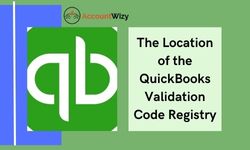This post will teach us about “The Location of the QuickBooks Validation Code Registry” This article will, in our opinion, be the most informative about the QuickBooks validation key. As quickly as possible, read the article. To validate your freshly purchased QuickBooks Desktop software, you will need a license key or a validation code. If you purchase QuickBooks software installation discs, the licensing information is on the label on the packaging, and it is in the confirmation email if you purchase the software online. Following a reinstall or update. You may also visit this page and read additional information if you’re looking for the QBO Login. If you lose your license key, your QuickBooks application will not run. Fortunately, you may immediately locate the QuickBooks validation code in the registry and utilize it to reactivate the program.
1. Where can I get the QuickBooks license number in the registry?
How to Locate the QuickBooks Licence Number in the Registry
-
Press the F2 key on your keyboard to set QuickBooks Desktop.
-
When the Product Registration window appears, press the F3 key.
-
This will launch the Tech Support window.
-
Go to the Open File tab and choose the QBRegistration.dat file from the list of files.
-
If the file does not open automatically, click OK after selecting Notepad from the list of programs.
-
In the search box, press Ctrl + F and type LicenseNumber.
-
When you press the Find button, the text in the file will be highlighted.
-
The product license registration number is visible next to the highlighted text.
-
Close the file after noting the license number/validation code.
-
Using the license number, you may now rapidly re-register the application.
2. Where does QuickBooks license data reside?
This file can then be copied with licensing and user registration information to get started with the QuickBooks program. On Windows, QBL files are often saved in the ProgrammeFilesIntuitQuickBooksINET directory.
3. What is the code for your validation?
A validation code is a series of three or four numbers found on the front or back of a debit/credit card. When using a debit/credit card to make an online or over-the-phone purchase, the code adds an extra degree of security.
4. What is the purpose of the QuickBooks validation code generator?
A QuickBooks Validation Code Generator generates a one-of-a-kind code that is used to identify a QuickBooks software license. When registering QuickBooks with Intuit or contacting customer assistance, this number is required. The license number can be found on the order confirmation email or the QuickBooks purchase receipt.
5. How many QuickBooks licenses do I currently have?
To open Product Information in QuickBooks, press the F2 on your keyboard. Examine the number of User Licenses indicated.
6. How can I obtain my QuickBooks certification?
Here’s how to get started with a course and pass an exam to become certified.
Step 1: Begin a new fitness program. Launch QuickBooks Online Accountant.
Step 2: Take a certification exam. Visit ProAdvisor.
Step 3: Receive your certificates and badges.
Step 4: Submit your certificate of Continuing Professional Education (CPE) for credit.
7. How many machines can QuickBooks be installed on?
The regular QuickBooks Pro license allows you to install the software on up to three PCs. It also provides a feature for multiple companies. It should be noted that one license is required for each user. If no one will be accessing QuickBooks on the server, it does not count as a user.
8. What are the four types of validation?
Process validation can be classified into four types based on the stage of the production life cycle at which it is performed:
-
Prospective Validation.
-
Retrospective Validation.
-
Concurrent Validation.
-
Revalidation.
9. Where is the XML file saved in QuickBooks?
Quickbooks creates an XML file and informs you that it is sending you to the CRA website. It is critical that you take special note of the location of the XML file, which is provided in this letter since you will need to attach it when you arrive at the CRA site. This is frequently saved in your computer’s “documents” folder.
10. What exactly is the distinction between numerical validation and verification?
The goal of verification is to find and eliminate faults in the model by comparing numerical results to analytical or extremely accurate benchmark solutions. In contrast, validation is focused on quantifying the model’s accuracy by comparing numerical solutions to experimental data, and if you’re looking for the Quickbooks File Doctor, you can also go to this page and read more information about it.




